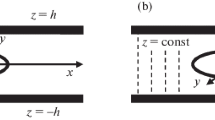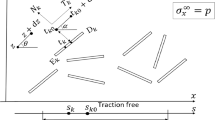Abstract
The problem of kinking of internal cracks in infinite plates submitted to antiplane shear at infinity was solved by using the Mellin transform. This transform allows a straightforward reduction of it to a system of second order Fredholm integral equations for a pair of functions in terms of which the stress intensity factors at the crack tips may be calculated. Of great interest and of equivocal views is the regime at the vicinity of the corner, the region where the kink is nucleated, and which reflects numerical difficulties arising in the solution of the integral equations. For this purpose an asymptotic expansion is constructed for their kernels and subsequently for the values of SIFs with respect to the length ε of the kinked branch. The analysis yielded results which were physically sound, but differing fundamentally with those existing in the literature. These results were in agreement with those obtained for an in-plane loading of the cracks and for cracks in bi-phase materials whose tips are on the interface of the phases.
Résumé
On propose une solution au problème des déviations de fissures internes dans une plaque infinie soumise à l'infini à un cisaillement antiplanaire, en utilisant une transformée de Mellin.
Cette transformée, appliquée à un couple de fonctions grâce auxquelles on peut calculer les facteurs d'intensité de contraintes aux extrémités d'une fissure, conduit à réduire le problème à un système d'intégrales de Fredholm du deuxième ordre. La situation régnant au voisinage du bord de la plaque, une région où s'amorcent les déviations, est particulièrement intéressante et prête à des interprétations équivoques; ceci reflète les difficultés que l'on peut rencontrer dans la solution numérique des intégrales. Pour y remédier, on établit une expansion asymptotique pour leur kernel, et donc pour les valeurs des facteurs d'intensité de contrainte, en fonction de la longueur ε de la branche déviée.
L'analyse conduit à des résultats qui ont un sens physique, mais qui diffèrent profondément de ceux qui l'on trouve dans la littérature. Ces résultats se révèlent en accord avec ceux obtenus dans le cas d'une sollicitation de fissures dans leur plan et dans le cas de fissures dans des matériaux biphasiques, pour lesquelles les extrémités de fissure seraient situées à l'interface entre les phases.
Similar content being viewed by others
References
H.I. Andersson, International Journal of Fracture 5 (1969) RCR 371–372.
M.A. Hussain, S.L. Pu and J. Underwood, ASTM STP 560 (1974) 2–28.
S.N. Palaniswamy and W.G. Knauss, in Mechanics Today 4, S. Nemat-Nasser (ed.), Pergamon (1978) 87–145.
S.N. Chatterjee, International Journal of Solids and Structures 11 (1975) 521–538.
C.H. Wu, Journal of Elasticity 8 (1978) 183–205.
C.H. Wu, private communication.
B.A. Bilby and G.E. Cardew, International Journal of Fracture 11 (1975) RCR708–712.
B.A. Bilby, G.E. Cardew and I.C. Howard, in Fracture 1977, University of Waterloo, 3 (1977) 197–200.
A.A. Khrapkov, International Journal of Fracture 7 (1971) 373–382.
R. Muki and R.A. Westmann, Journal of Elasticity 4 (1974) 173–186.
S. Tanaka and M. Ichikawa, International Journal of Fracture 15 (1979) RCR49–50.
P.S. Theocaris and G.N. Makrakis, Journal of Elasticity 16 (1986) 393–411.
P.S. Theocaris, Journal of Mechanics and Physics of Solids 20 (1972) 265–279.
V.G. Mazya, S.A. Nazarov and B.A. Plamenevskii, Soviet Physics Doklady 24 (1979) 904–905.
K.E. Atkinson, SIAM Journal of Numerical Analysis 4 (1967) 337–2348.
A. Abramowitz and J.A. Stegun, Handbook of Mathematical Functions, Dover Publications, New York (1969) 890–893.
G. Sih, Journal of Applied Mechanics 32 (1965) 181–183.
P.S. Theocaris, Engineering Fracture Mechanics 15 (1981) 283–290.
R.J. Nuismer and G.P. Sendeckyj, Journal of Applied Mechanics 44 (1977) 625–630.
G.P. Sendeckyj, Engineering Fracture Mechanics 6 (1974) 33–45.
Author information
Authors and Affiliations
Rights and permissions
About this article
Cite this article
Theocaris, P., Makrakis, G. Crack kinking in anti-plane shear solved by the Mellin transform. Int J Fract 34, 251–262 (1987). https://doi.org/10.1007/BF00013081
Received:
Accepted:
Issue Date:
DOI: https://doi.org/10.1007/BF00013081




